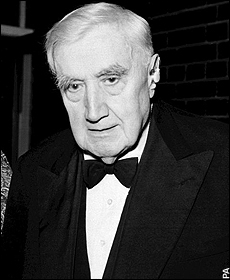Ralph Vaughan Williams (1872-1958)
Born October 12, 1872 in Down Ampney, Gloucestershire, England.
Died August 26, 1958 in London.
The Lark Ascending. Romance for Violin and Orchestra
Composed in 1914, revised 1920.
First Orchestral Performance: June 14, 1921 with Adrian Boult conducting the British Symphony Orchestra, Queen’s Hall London.
Instrumentation: solo violin, 2 flutes, oboe, 2 clarinets, 2 bassoons, 2 horns, triangle, and strings
The Lark Ascending was written in August 1914 for violinist Marie Hall. Unfortunately World War I (in which Vaughan Williams served as an ambulance driver with the Royal Army Medical Corps) broke out and the work was put aside until 1920, when it was revised and performed for the first time on December 15, 1920. Hall was the soloist accompanied by George Mendham playing the piano in Shirehampton Public Hall. The orchestral version received its premiere the following year again with Hall as the soloist. This was the same year he began Symphony No. 3
– his Pastoral Symphony.
The title is from a poem by Victorian English poet George Meredith (1828-1909) who lived in the same region as Vaughan Williams. The composer was inspired by the poem to portray the lark as a solo violin. The following extract from Meredith’s poem was published in the score at the composer’s request.
He rises and begins to round,
He drops the silver chain of sound,
Of many links without a break,
In chirrup, whistle, slur and shake.
For singing till his heaven fills,
‘Tis love of earth that he instils,
And ever winging up and up,
Our valley is his golden cup
And he the wine which overflows
to lift us with him as he goes.
Till lost on his aerial rings
In light, and then the fancy sings.
The piece is a simple A-B-A form. The strings and winds quietly open the work with a series of sustained chords. The violin representing the lark enters softly with a series of birdlike ascending, repeated motifs – “He rises and begins to round” – which grow into the main theme.
Example 1.

[wpaudio url=”http://genedelisa.com/wordpress/wp-content/uploads/mp3/2007/01/Example7.mp3″ text=”Play” dl=”0″]
The middle section of the piece is a folk-like tune for orchestra followed by the return of the violin which leads to a reiteration of the original theme by the full strings. The work ends softly with the solo violin repeating its initial ascending motifs in a final flight “Till lost on his aerial rings.”
Resources
[amazon template=iframe image&asin=B0002CX4Q8][amazon template=iframe image&asin=0193692031]
